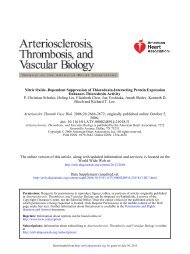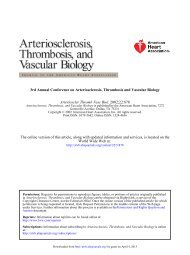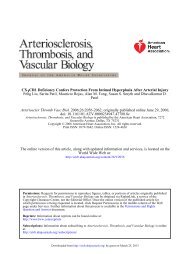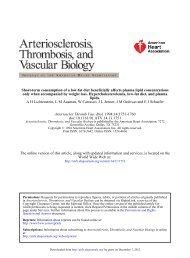Physiologic and Supraphysiologic Increases in Lipoprotein Lipids ...
Physiologic and Supraphysiologic Increases in Lipoprotein Lipids ...
Physiologic and Supraphysiologic Increases in Lipoprotein Lipids ...
You also want an ePaper? Increase the reach of your titles
YUMPU automatically turns print PDFs into web optimized ePapers that Google loves.
416 ARTERIOSCLEROSIS VOL 4, No 4, JULY/AUGUST 1984<br />
A f<strong>in</strong>al argument that a supraphysiologic rise <strong>in</strong><br />
plasma triglyceride antepartum is a pathophysiologic<br />
process signify<strong>in</strong>g an underly<strong>in</strong>g prelipemic trait is<br />
based on the fact that all three subjects for whom<br />
relatives were available show evidence of hyperlipidemia<br />
among family members. The difference<br />
among the subjects' responses to pregnancy, as well<br />
as the available <strong>in</strong>formation among relatives, suggests<br />
that the designation of prelipemia could represent<br />
several dist<strong>in</strong>ct <strong>and</strong> possibly genetic underly<strong>in</strong>g<br />
disorders of lipoprote<strong>in</strong> metabolism. Further <strong>in</strong>vestigations<br />
of larger numbers of prelipemic women with<br />
<strong>in</strong>-depth family studies are necessary to resolve this<br />
question. In addition, long-term follow-up will be necessary<br />
to verify the hypothesis that the hyperlipidemic<br />
stress of pregnancy can unmask a prelipemic<br />
trait. Nonetheless, it is noteworthy that subject CB<br />
has rema<strong>in</strong>ed hyperlipidemic for almost 2 years<br />
s<strong>in</strong>ce delivery, her only normal value hav<strong>in</strong>g been<br />
obta<strong>in</strong>ed before the pregnancy we observed.<br />
While the postpartum observations made at specific<br />
times <strong>and</strong> the dist<strong>in</strong>ctions between subjects with<br />
physiologic <strong>and</strong> supraphysiologic lipid <strong>in</strong>creases <strong>in</strong><br />
pregnancy are entirely new, our antepartum observations<br />
confirm several previously described features<br />
of hyperlipidemia <strong>in</strong> pregnancy. These <strong>in</strong>clude<br />
an <strong>in</strong>crease <strong>in</strong> total <strong>and</strong> VLDL apo B, 24 little or no<br />
change <strong>in</strong> VLDL composition, 2 2425 an <strong>in</strong>crease <strong>in</strong><br />
triglyceride content of LDL <strong>and</strong> HDL, 22425 <strong>and</strong> an<br />
<strong>in</strong>crease <strong>in</strong> apo A-l. 26 Thus, conclusions drawn from<br />
this paper can be considered to be generally representative<br />
of the body of <strong>in</strong>formation on hyperlipidemia<br />
<strong>in</strong> pregnancy.<br />
The possibility that the hyperlipidemia of pregnancy<br />
might confer added arteriosclerosis risk has<br />
recently been raised. 2728 While it is true that an <strong>in</strong>crease<br />
<strong>in</strong> LDL cholesterol could enhance arteriosclerosis,<br />
usually this change is associated with an apo<br />
B-rich 29 <strong>and</strong> triglyceride-poor LDL, 30 which is the opposite<br />
of that seen <strong>in</strong> pregnancy. In addition, HDL<br />
cholesterol <strong>and</strong> apo A-l concentrations were <strong>in</strong>creased,<br />
which may facilitate cholesterol removal<br />
from tissues. In light of these results, it is perhaps not<br />
surpris<strong>in</strong>g that the epidemiologic evidence 31 that<br />
arteriosclerosis is more common <strong>in</strong> multiparous<br />
women is <strong>in</strong>conclusive. It is more likely that the observed<br />
lipoprote<strong>in</strong> changes serve a physiological<br />
purpose to support growth of maternal <strong>and</strong> fetal tissues<br />
<strong>and</strong> production of large quantities of steroid<br />
hormones. 5 ' 16 The extent to which the postpartum<br />
lipoprote<strong>in</strong> changes are atherogenic is deserv<strong>in</strong>g of<br />
further study.<br />
In summary, evidence is presented to support the<br />
hypothesis that the hyperlipidemic stress of pregnancy<br />
can unmask a latent hypertriglyceridemia, by<br />
us<strong>in</strong>g as a basis for recognition a triglyceride rise <strong>in</strong><br />
pregnancy exceed<strong>in</strong>g the 95th percentile. Women<br />
with such a supraphysiologic triglyceride rise antepartum<br />
may return to normal levels postpartum more<br />
slowly than normal, have LDL lipids that change <strong>in</strong> an<br />
atypical manner antepartum <strong>and</strong> postpartum, have<br />
Downloaded from<br />
http://atvb.ahajournals.org/ by guest on June 29, 2013<br />
HDL cholesterol concentrations that are persistently<br />
low antepartum <strong>and</strong> postpartum, <strong>and</strong> have hyperlipidemic<br />
family members. In contrast, hypercholesterolemia<br />
is not greatly exaggerated <strong>in</strong> pregnancy. Longterm<br />
follow-up studies of women with genetically<br />
well-characterized disorders of lipoprote<strong>in</strong> metabolism<br />
are required to determ<strong>in</strong>e if an abnormal lipoprote<strong>in</strong><br />
response <strong>in</strong> pregnancy can identify prelipemic<br />
subjects <strong>and</strong> dist<strong>in</strong>guish among the major disorders<br />
of lipoprote<strong>in</strong> metabolism. Identification of prelipemia<br />
will provide an opportunity to study prospectively<br />
the natural progression, potential for atherosclerosis,<br />
<strong>and</strong> possible treatment of hyperlipidemia from<br />
early adulthood.<br />
Acknowledgments<br />
The authors express their thanks to the staff of the Northwest<br />
Liptd Research Cl<strong>in</strong>ic Core Laboratory who performed analyses;<br />
to Susan Irv<strong>in</strong>e who carefully obta<strong>in</strong>ed the samples; to the gracious<br />
women of the Childbirth Education Association who volunteered<br />
for participation <strong>in</strong> the study; <strong>and</strong> to Donna Gola <strong>and</strong> Lori<br />
Lebon for excellent secretarial assistance.<br />
References<br />
1. O'Sulllvan JB, Mahan CM. Criteria for the oral glucose tolerance<br />
test <strong>in</strong> pregnancy. Diabetes 1964;13:278-285<br />
2. Knopp RH, Warth MR, Carroll CJ. Lipid metabolism <strong>in</strong> pregnancy.<br />
I. Changes <strong>in</strong> lipoprote<strong>in</strong> triglyceride <strong>and</strong> cholesterol <strong>in</strong><br />
normal pregnancy <strong>and</strong> the effects of diabetes mellitus. J Reprod<br />
Med 1973;10:95-101<br />
3. D<strong>and</strong>row RV, O'Sulllvan JB. Obstetric hazards of gestational<br />
diabetes. Am J Obstet Gynecol 1966;96:1144-1147<br />
4. O'Sulllvan JB. Gestational diabetes: Unsuspected, a symptomatic<br />
diabetes <strong>in</strong> pregnancy. N Engl J Med 1961;264:<br />
1082-1085<br />
5. Knopp RH, Bergelln RO, Wahl PW, Walden CE, Chapman<br />
M, Irv<strong>in</strong>e S. Population-based lipoprote<strong>in</strong> lipid reference values<br />
for pregnant women compared to nonpregnant women<br />
classified by sex hormone use. Am J Obstet Gynecol<br />
1982;143:626-637<br />
6. Wahl PW, Walden CE, Albere JJ, et al. Distribution of lipoprote<strong>in</strong><br />
triglyceride <strong>and</strong> lipoprote<strong>in</strong> cholesterol <strong>in</strong> an adult population<br />
by age, sex, <strong>and</strong> hormone use: The Pacific Northwest<br />
Bell Telephone Company Health Survey. Atherosclerosis<br />
1981;39:111-124<br />
7. Knopp RH, Warnlck GR, Walden CE, el al. Relationship of<br />
gender, sex hormone use, <strong>and</strong> age with lipoprote<strong>in</strong> cholesterol/triglyceride<br />
ratios <strong>in</strong> an adult population: The Pacific Northwest<br />
Bell Telephone Company Health Survey. Atherosclerosis<br />
1981:39:133-146<br />
8. Hoover JJ, Walden CE, Bergelln RO, et al. Cholesterol <strong>and</strong><br />
triglyceride distributions <strong>in</strong> an adult employee population: The<br />
Pacific Northwest Bell Telephone Company Health Survey.<br />
<strong>Lipids</strong> 1980:15:895-903<br />
9. Lipid Research Cl<strong>in</strong>ics Program. Manual of laboratory operations,<br />
Vol 1: Upid <strong>and</strong> lipoprote<strong>in</strong> analysis. (DHEW pub.<br />
no. (NIH) 75-628. Wash<strong>in</strong>gton, DC: U.S. Government Pr<strong>in</strong>t<strong>in</strong>g<br />
Office, 1974<br />
10. Hatch FT, Lees RS. Practical methods for plasma lipoprote<strong>in</strong><br />
analysis. In: Paoletti R, Kritchevsky R, eds. Advanced Upid<br />
Research, vol 6. 1968:1-68<br />
11. Albers JJ, Cabana VG, Hazzard WR. Immunoassay of human<br />
plasma apolipoprote<strong>in</strong> B. Metabolism 1975:24:1339-<br />
1351














